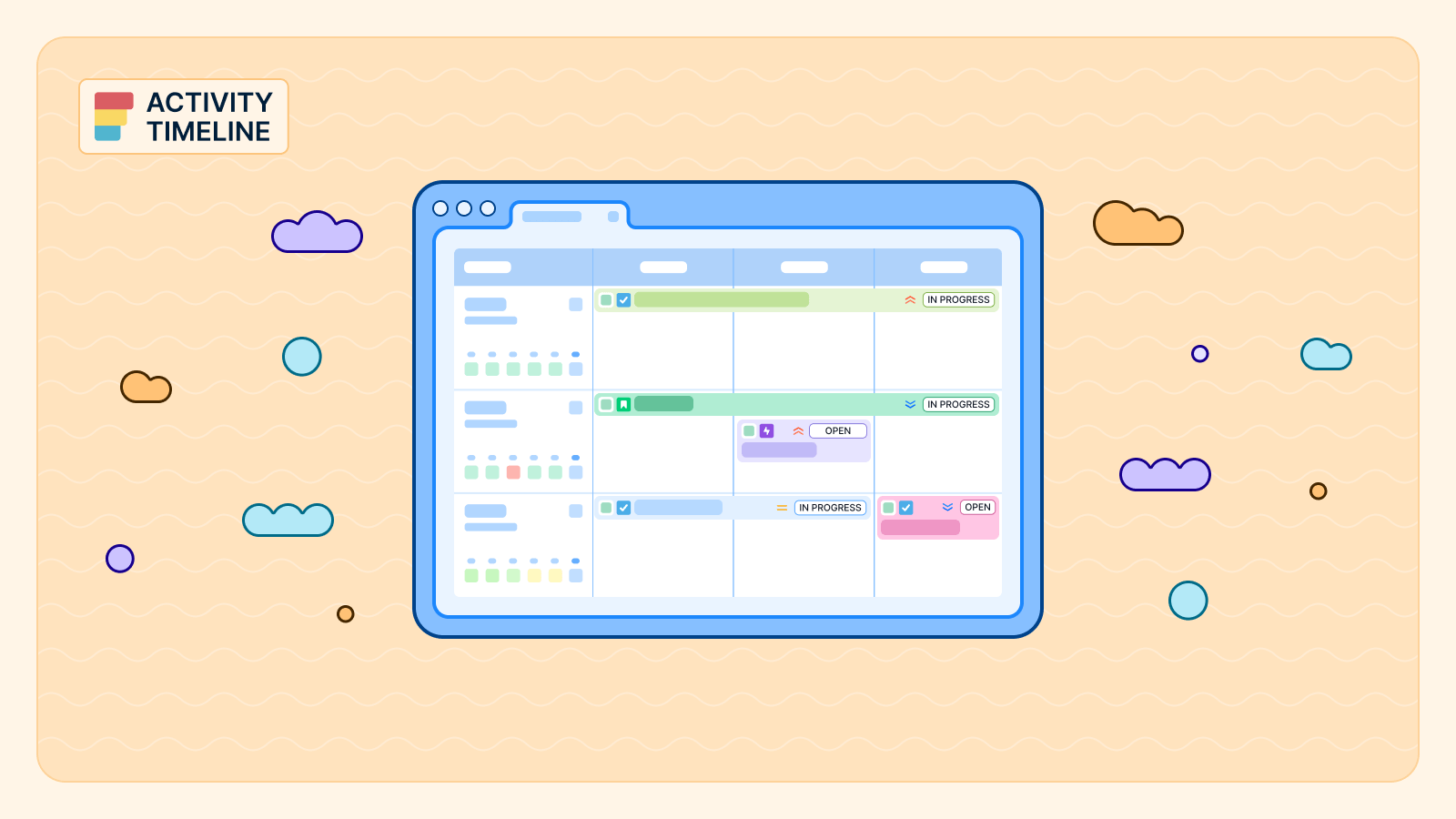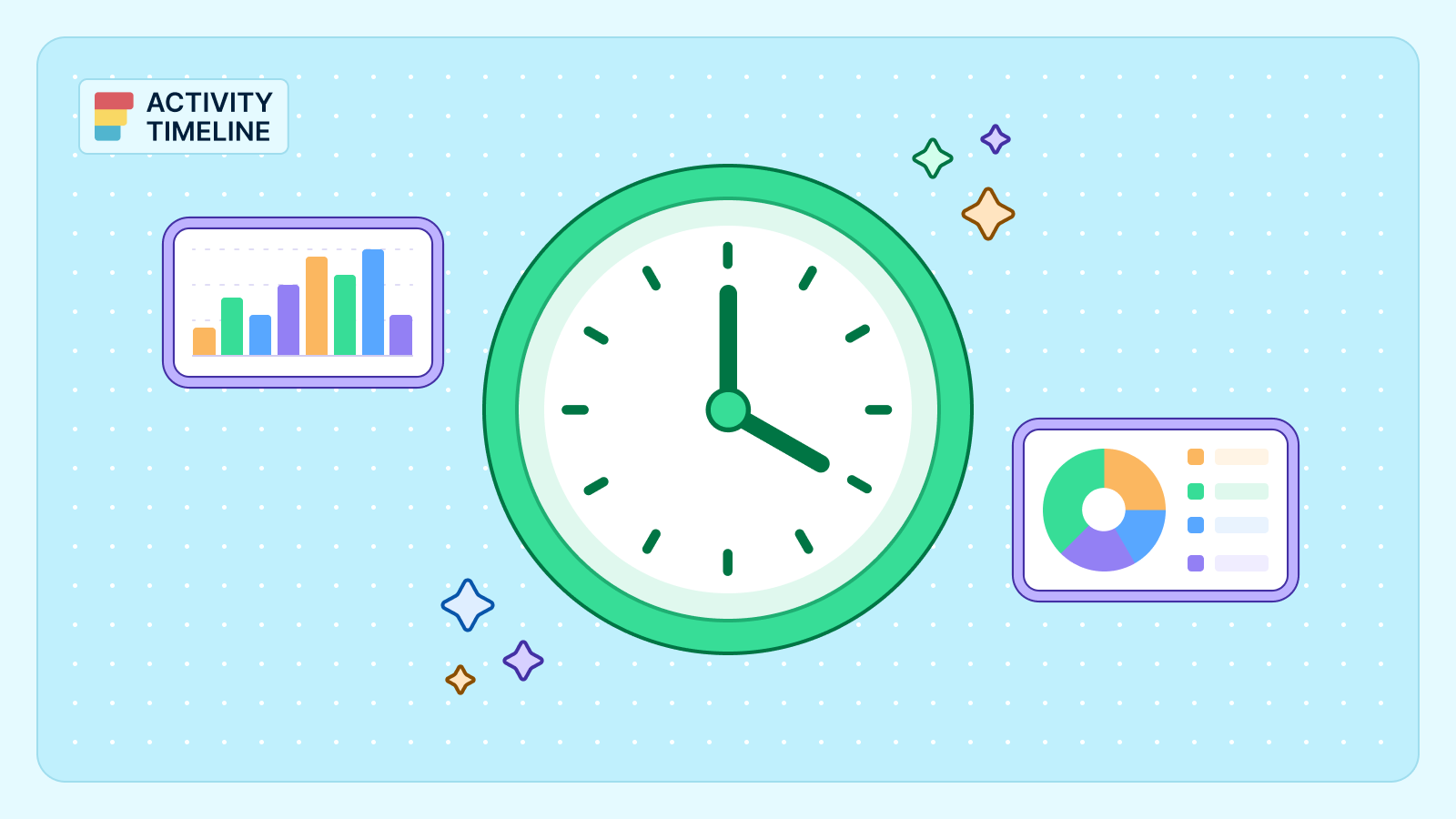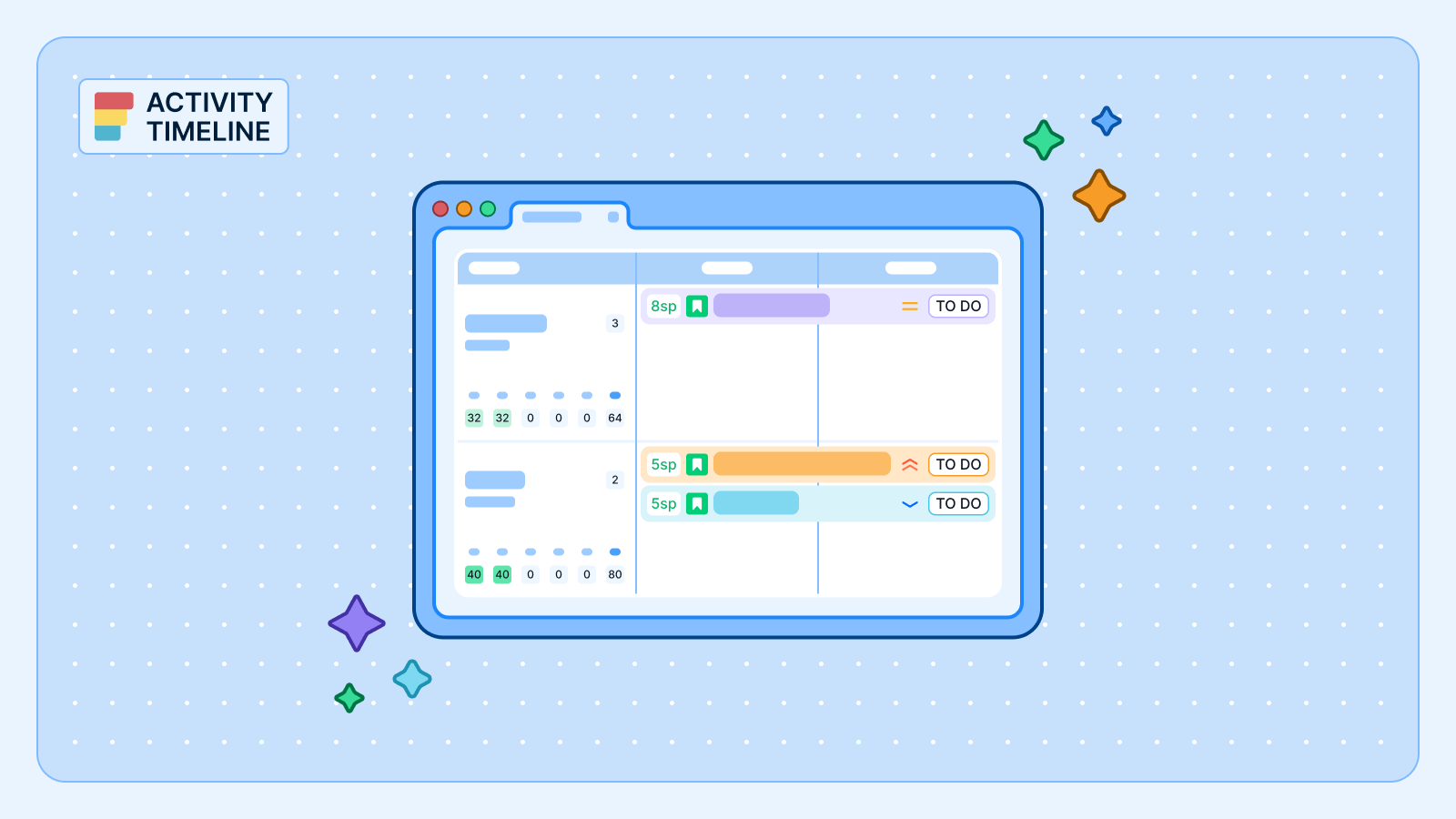{{tl-dr}}
Managing team schedules effectively is paramount. Yet, many organizations still grapple with fragmented data, static spreadsheets, and a lack of real-time visibility into who is doing what, when, and how much capacity they truly have. This often leads to a reactive approach, where problems like missed deadlines, resource contention, and employee burnout are identified too late.
You need a solution that transforms disparate task assignments into a coherent, actionable overview. You need a platform that empowers you to visualize, analyze, and optimize your team's workload at a glance. This is precisely where ActivityTimeline shines, providing a comprehensive and intuitive way to onboard and manage your team schedules.
The Fog of Fragmented Schedules
Imagine trying to navigate a complex project without a map, relying only on individual compass readings. That's often the reality for project managers without a centralized, dynamic tool for team scheduling. The consequences of poor schedule visibility are far-reaching:
- Missed Deadlines: Without a clear overview, you might overcommit resources or fail to allocate enough time for critical tasks, leading to project delays.
- Resource Overload & Burnout: It’s easy to inadvertently assign too much work to your top performers if you can't see their full workload across all projects. This leads to stress, decreased productivity, and ultimately, burnout.
- Underutilization: Conversely, some team members might be underutilized, leading to inefficiencies and wasted potential. Identifying these gaps without a visual tool is challenging.
- Communication Breakdowns: When schedules are opaque, team members struggle to coordinate, understand dependencies, and support each other effectively.
- Lack of Agility: Adapting to new priorities or unexpected changes becomes a nightmare when you can't quickly re-plan and visualize the impact.
These challenges don't just affect project timelines; they impact team morale, budget adherence, and ultimately, your organization's bottom line.
Your Crystal Ball for Resource Planning: The Planner Module
ActivityTimeline is designed to cut through this complexity, offering a straightforward user interface in an easy-to-understand timeline format, where you can see with the flow of time how your plan changes, what is progress and where are the potential bottlenecks. The Planner module is the central hub for gaining this comprehensive overview of team schedules.
The Planner consists of two main components: the Issues Panel on the left and the Timeline Panel on the right. The Issues Panel serves as your backlog, displaying all Jira tasks from your enabled projects, ready for planning. The Timeline Panel, on the other hand, is your visual workspace, allowing you to see how tasks are spread across time for individual users and entire teams.
{{rich-cta-1}}
Mastering the Planner: A Walkthrough to Visualizing Schedules
ActivityTimeline empowers you to visualize and interact with your team's schedule like never before.
1. Filtering by Team, Project, and Time Period
To gain the overview you need, the Planner offers robust filtering capabilities:
- Team and User Views: You can easily "Switch between 'User' and 'Teams' using the dropdown on the top panel" to view individual timelines or aggregated team schedules. This allows you to review your team's current tasks, deadlines, and availability across multiple projects and teams in a single, unified timeline.
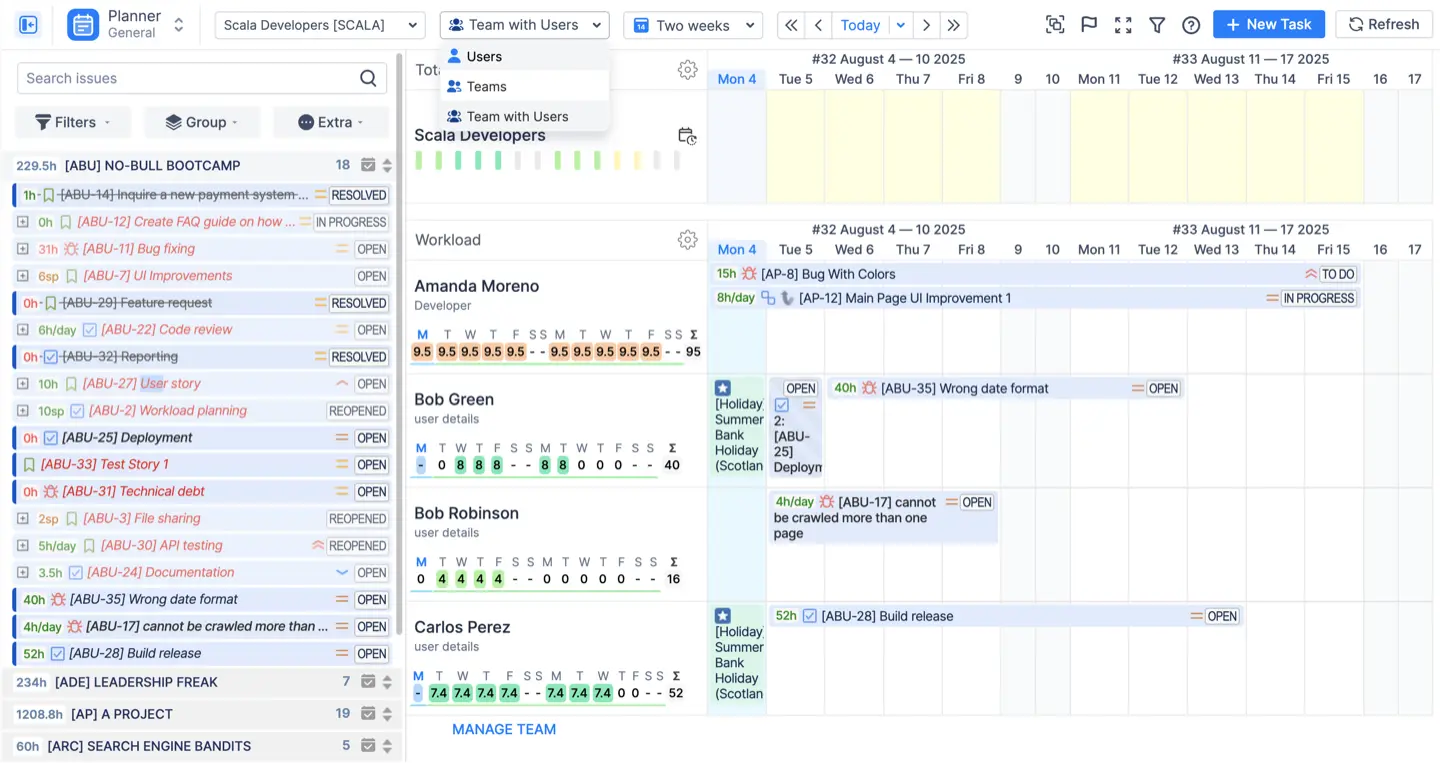
- Project Filtering: The Issues Panel allows you to apply various filters, including filtering by project, to narrow down the tasks you see.
- Flexible Time Periods: The Timeline Panel lets you adjust your view to different time horizons, from Week, Two Weeks, Month-Daily, Month-Weekly, Two Months, Quarter, Half a Year, Year. This flexibility is crucial for both short-term tactical planning and long-term strategic forecasting.
2. Identifying Overlapping Tasks or Schedule Gaps
One of ActivityTimeline's most powerful features is its Workload Indicator. This visual cue, displayed under each resource name, instantly shows you how much a person is loaded compared to his/her capacity (involvement).
- Overloaded Resources: If a person is assigned more work than their capacity, the workload indicator will turn red. This immediately signals an overlapping task or an overcommitted schedule, prompting you to adjust assignments to prevent burnout.

- Underutilized Resources / Schedule Gaps: Conversely, a lighter shade of green or yellow indicates that "not enough work is scheduled" or that the resource is underloaded. This helps you identify available capacity and fill schedule gaps, ensuring optimal utilization of your team.
- Milestone Panel for Sprints and Deadlines: The Milestone Panel provides a high-level view of your sprints and key deadlines, appearing above team members' timelines. It helps you visualize major project phases and ensure tasks are aligned with overarching project goals, preventing unexpected deadline clashes.
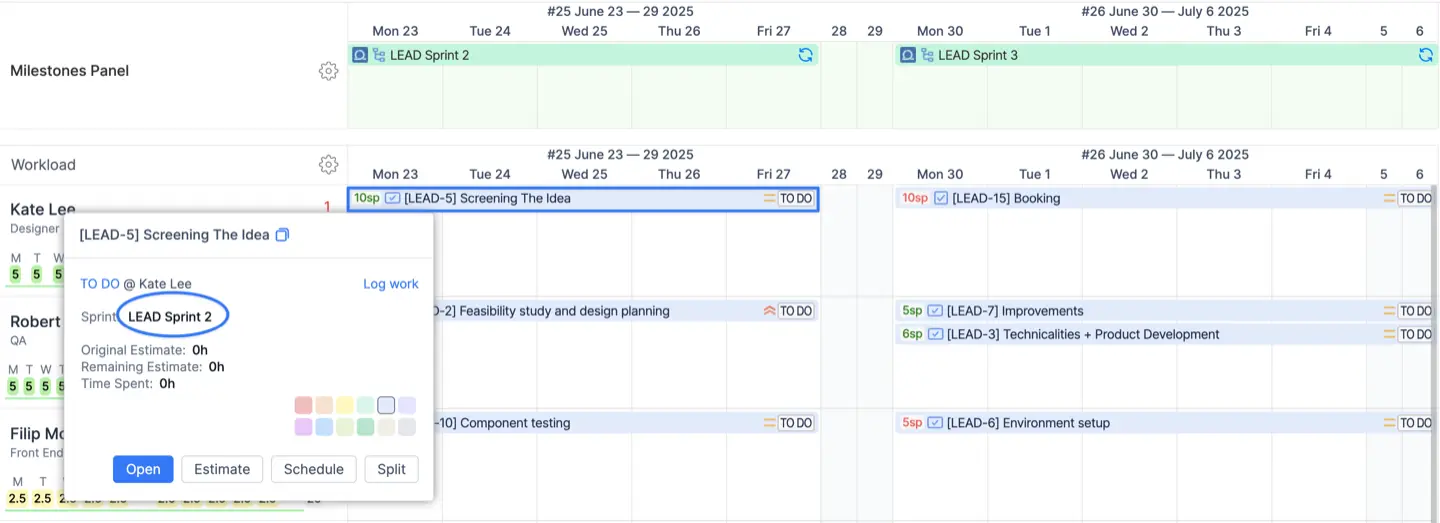
3. Adjusting Plans Directly on the Timeline
ActivityTimeline empowers you to be proactive. When you identify an issue on the timeline, you can "drag'n'drop" Jira tasks directly from the Issue Panel onto a user's timeline. Beyond initial assignment, you can:
- Reschedule: Drag and drop tasks to new dates or different users.
- Resize: Extend or shorten task durations directly on the timeline.
- Split Tasks: Divide a single task between different users or across multiple dates if needed.
- Create Custom Events: Beyond Jira tasks, you can create custom events directly from the Timeline panel. This is invaluable for scheduling non-Jira activities like bookings for daily meetings, vacation scheduling, business trip booking, sick leaves, or days off. These custom events also impact workload calculations.
4. Using Color Codes and Legends for Easier Interpretation
ActivityTimeline utilizes intuitive color-coding to make schedule interpretation effortless:
- Workload Indicator Colors: As mentioned, red signifies overload, yellow indicates underload, and green means optimal workload.
- Issue Card Customization: The appearance is customizable and can be adjusted according to the user's needs. You can configure Issue Type, Issue Priority, and Issue State icons, as well as estimates and due dates on each task bar, providing quick visual cues about task status and importance.
- Overdue Indicators: Tasks with missed due dates will appear with a minus value and a red color, clearly highlighting overdue items.
This visual language allows you to quickly scan complex schedules, identify bottlenecks, and make informed decisions, transforming raw data into actionable insights.
Real-World Applications Where ActivityTimeline Shines
ActivityTimeline is designed to help organizations navigate the complexities of modern project and resource management, transforming common pain points into streamlined, visible processes. Here are some real-world applications where ActivityTimeline truly shines:
Optimizing Resource Allocation and Preventing Burnout
Many organizations struggle with knowing who is available, when, and for what kind of work. ActivityTimeline helps you solve this by providing a clear overview of individual and team capacity, ensuring that resources are fully utilized but not overloaded.
For instance, if a project manager needs to assign new tasks, they can quickly see a workload indicator under each resource, showing if a person is "overloaded" (red), "underloaded" (yellow), or has "perfect" (green) allocation compared to their capacity. This means managers can efficiently assign tasks based on availability and skills, preventing the common issue of some team members showing as available even when they have planned work scheduled.
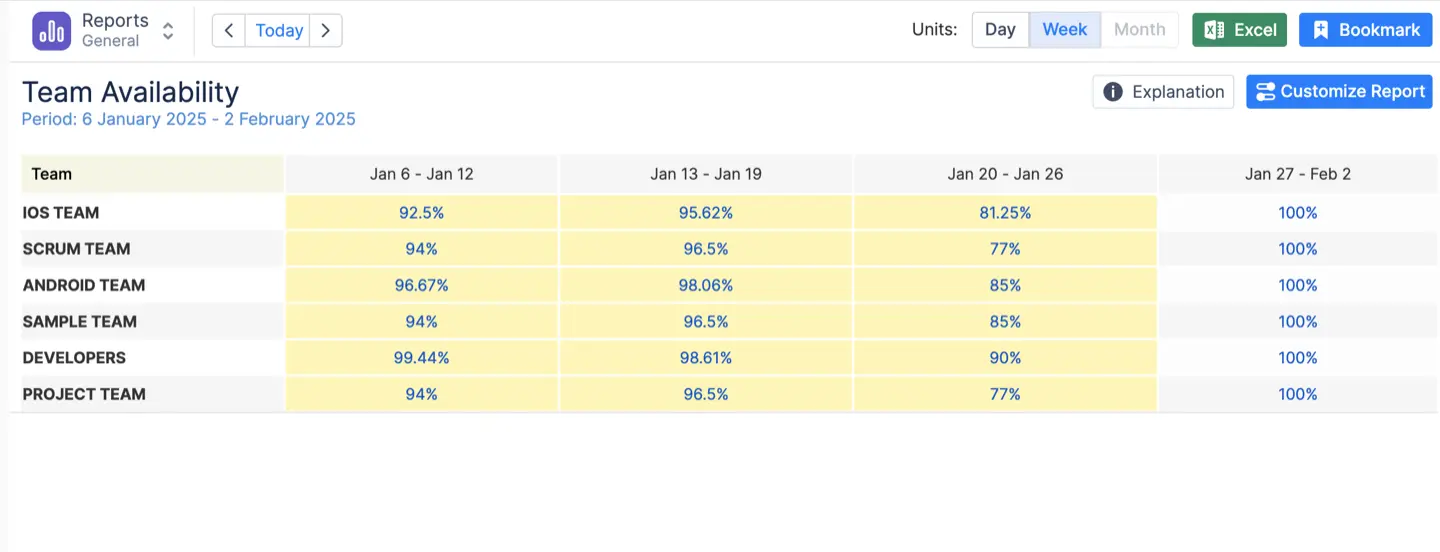
The tool can even automatically schedule Jira tickets on a person's timeline based on their availability, adjusting if there are vacations or days off.
Achieving Comprehensive Time Tracking and Insightful Reporting
Beyond simply logging time, ActivityTimeline provides powerful ways to track and analyze how time is spent. Organizations often need to track actual versus planned time on projects and tasks. ActivityTimeline enables this through various reports, helping to spot the difference between original estimate & actual execution to understand project bottlenecks. You can generate detailed timesheet reports that can be grouped by project or user, allowing managers to inspect individual worklogs, verify approvals, and review details like time spent and comments.
For teams needing to distinguish between different types of work, ActivityTimeline supports categorizing time entries into "Billable" and "Non-Billable," along with up to 100 custom categories. This helps teams answer critical questions like "how much time is being spent on each customer in each sprint or each month".
Seamlessly Managing Absences and Non-Project Work
Effective planning requires accounting for all types of time, not just Jira tasks. ActivityTimeline helps organizations manage vacations, sick leaves, days off, and holidays. These "non-working events" decrease a user's capacity for work, helping managers accurately gauge available workforce and adjust project timelines accordingly. The platform also allows for tracking time spent on activities not directly related to Jira issues, such as meetings or training sessions. This ensures a complete overview of all work performed and helps solve the problem of capturing time on external activities like meetings without creating duplicate entries.
Flexible Planning for Unique Organizational Structures
ActivityTimeline offers flexibility for diverse planning needs. You can create custom event types beyond standard Jira issues, such as "Booking" events to reserve resources for a specific activity or project without linking to an exact Jira task, or "Placeholder" events to try different planning scenarios without altering Jira issues. The tool also supports managing "Resources" that are not Jira users, which can include non-human resources like rooms or equipment, or even potential new employees for strategic capacity planning. Its user roles and permissions system allows for granular control over what users can see and do, from full administrative access to limited employee views. This adaptability ensures ActivityTimeline can cater to a wide range of operational models, from tracking time on JSM issues to supporting teams with different working hours across various time zones.
The Future of Team Orchestration is Here
Gaining a comprehensive overview of team schedules is no longer a luxury; it's a necessity for modern project management. ActivityTimeline's Planner module provides the real-time visibility, interactive controls, and intuitive visual cues you need to:
- Prevent resource overload and team burnout.
- Maximize team utilization and efficiency.
- Proactively address potential delays.
- Foster a more transparent and collaborative work environment.
By adopting ActivityTimeline, you're not just getting a scheduling tool; you're gaining a strategic advantage, empowering your team to achieve more with greater clarity and less friction.
{{rich-cta-2}}


